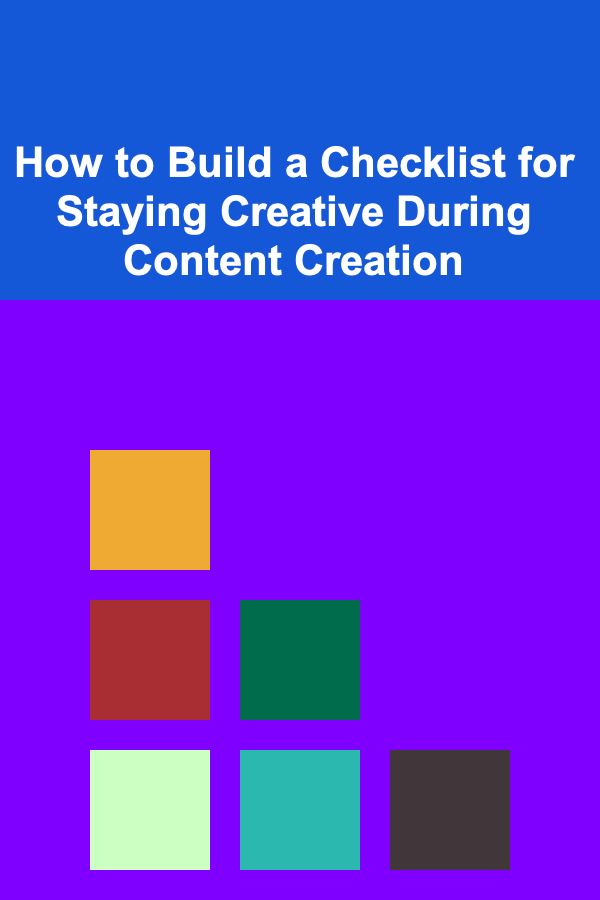
How to Build a Checklist for Staying Creative During Content Creation
ebook include PDF & Audio bundle (Micro Guide)
$12.99$10.99
Limited Time Offer! Order within the next:

Creativity is often described as a spark that comes out of nowhere, but for content creators, maintaining a consistent flow of creativity can sometimes feel like a challenge. Whether you're writing blog posts, creating videos, or designing graphics, staying creative while producing high-quality content is essential for keeping your audience engaged and your work fresh. To achieve this, building a checklist to stay organized, inspired, and motivated is a practical approach.
In this guide, we'll explore how to build a comprehensive checklist that helps you stay creative during the content creation process. We'll cover the importance of each step and provide actionable strategies to ensure that your creative flow stays intact, no matter the medium or project.
Define Your Purpose and Goals
Before diving into any content creation project, it's crucial to understand your purpose. Why are you creating this content, and what do you hope to achieve? Whether it's educating, entertaining, or persuading, knowing your objectives will help you maintain focus and guide your creative decisions.
Actionable Steps:
- Clarify the Core Message: What is the central idea or value of the content? For instance, if you're writing a blog post, identify the key takeaway you want the reader to remember.
- Set Clear Goals: Decide on specific outcomes you want to achieve. Are you aiming for a certain number of views, shares, or a particular level of engagement? These goals will help measure the success of your creative efforts and keep you on track.
Actionable Tip:
Write down your goals in a content calendar or project management tool. This will allow you to visualize your progress and see how each piece of content fits into your overall strategy.
Create a Routine for Inspiration
Creativity can often feel elusive, but a consistent routine can make it easier to tap into that creative spark. By establishing habits that nurture creativity, you can make it easier to find inspiration when you need it most.
Actionable Steps:
- Set Time for Exploration: Dedicate time each day to explore new ideas. Read books, watch videos, listen to podcasts, or explore social media for inspiration. This can stimulate new thoughts and help you see things from a different perspective.
- Keep a Creative Journal: Carry a notebook or digital app where you can jot down ideas, concepts, or even random thoughts throughout the day. Often, inspiration strikes in the most unexpected moments, and capturing these ideas immediately will help you build a reservoir of creative material.
Actionable Tip:
Try a daily creativity exercise, like brainstorming a list of 10 potential topics for your next piece of content, regardless of how seemingly mundane they may seem. This will help you keep the creative muscle active.
Limit Distractions
In the age of constant notifications and digital interruptions, staying creative can be hard. Reducing distractions is essential for maintaining focus and creating high-quality content without the stress of outside noise.
Actionable Steps:
- Designate a Creative Space: Create a dedicated environment for content creation. This could be a home office, a quiet corner in a café, or any space that helps you concentrate.
- Turn Off Notifications: Put your phone on "Do Not Disturb" mode, close unnecessary browser tabs, or use apps that block distracting websites while you work. This allows you to stay in a flow state without interruptions.
Actionable Tip:
Try the Pomodoro technique: work for 25 minutes, then take a 5-minute break. This will help you stay focused during the intense work periods while allowing time for quick mental refreshment.
Embrace Constraints
It may seem counterintuitive, but limitations often boost creativity rather than stifle it. By setting constraints for your project, you'll force your brain to think outside the box and find unique solutions.
Actionable Steps:
- Set Time Limits: Give yourself a specific amount of time to brainstorm, write, or design. This urgency can spark creativity and prevent you from overthinking the process.
- Define Specific Parameters: Set specific guidelines for your content. For example, if you're creating a video, limit the length to 5 minutes or choose a specific color palette for a design. These boundaries will inspire you to make the most of what you have.
Actionable Tip:
Try working with tools that encourage creativity within constraints. For example, use a tool like Canva that provides templates, which force you to be creative within a specific design format.
Seek Feedback from Others
While it's important to trust your instincts, seeking feedback from others can give you fresh perspectives and reveal areas where your creativity can be improved. Whether it's from colleagues, fellow creators, or even your audience, constructive criticism can be an invaluable resource.
Actionable Steps:
- Peer Review: Share your work with a colleague or friend who can provide constructive feedback. Sometimes, an outside perspective can help you identify gaps or new ideas you hadn't considered.
- Engage with Your Audience: If you're creating content for social media, ask your followers for input. They can provide insights into what resonates with them and offer suggestions for improvement.
Actionable Tip:
Use tools like surveys or polls to engage your audience directly. Ask questions like, "What kind of content would you like to see more of?" or "What would improve your experience with our content?"
Take Breaks and Step Away
Even the most dedicated content creators need to step away from their work periodically to refresh their minds. Sometimes, taking a break is the best way to reignite your creativity.
Actionable Steps:
- Take Regular Breaks: Make sure to take time away from your workspace to recharge. Whether it's a walk outside, stretching, or a quick meditation session, a mental reset can bring clarity and new ideas.
- Change Environments: If you're feeling stuck, sometimes a change of scenery can do wonders. Work from a different location or rearrange your workspace to refresh your mental state.
Actionable Tip:
Consider scheduling "creative breaks" where you engage in activities unrelated to your content creation, like painting, journaling, or even cooking. These activities stimulate different parts of the brain, which can help spark new ideas for your projects.
Use Templates and Tools to Enhance Efficiency
While creativity often requires freedom, it's also important to enhance your workflow with tools and templates that can streamline repetitive tasks, giving you more mental space for creative thinking.
Actionable Steps:
- Use Content Templates: Whether for blog posts, video scripts, or social media graphics, templates help you organize your ideas and streamline the creation process. They provide a structure but leave room for creative expression.
- Leverage Design and Writing Tools: Tools like Canva for design, Grammarly for writing, and Trello for task management can save you time, making it easier to focus on the creative aspects of your work.
Actionable Tip:
Experiment with tools that automate certain parts of your creative process. For example, scheduling social media posts in advance can free up time to brainstorm fresh ideas without the pressure of managing daily posts.
Review and Reflect on Your Past Work
Sometimes, revisiting your old content can spark new creative ideas. Reflecting on your past projects can help you identify patterns, successful strategies, and areas for improvement.
Actionable Steps:
- Analyze Your Top Performing Content: What worked well in your previous content? Take note of what your audience responded to and find ways to build upon that success.
- Identify Areas for Improvement: Review content that didn't perform as well and analyze why. This reflection can help you adjust your creative approach moving forward.
Actionable Tip:
Create a "creative archive" where you store your past work, feedback, and notes. Over time, this will become a valuable resource for tracking your growth and generating new ideas.
Allow Room for Experimentation
Creativity thrives when you allow yourself the freedom to experiment and take risks. Don't be afraid to try something new, even if it doesn't always succeed.
Actionable Steps:
- Test New Formats: If you typically write articles, try creating videos or infographics. Experimenting with different formats can open up new creative avenues.
- Experiment with New Topics: Push the boundaries of your niche. If you're a lifestyle blogger, try writing about a topic outside of your usual themes to keep things fresh.
Actionable Tip:
Set aside time for "creative experiments" that have no specific goal other than to explore. These exercises can lead to unexpected breakthroughs or help you discover new creative directions.
Conclusion
Building a checklist to stay creative during content creation is not about adhering to a rigid set of rules, but rather about implementing strategies and habits that fuel your creative process. From defining your goals and creating a routine for inspiration to limiting distractions and seeking feedback, each step is designed to keep your creativity flowing. By staying organized and focused, while allowing room for exploration and experimentation, you'll find that staying creative becomes more of a habit and less of a challenge.
By adopting these strategies, you'll not only boost your creativity but also ensure that your content remains fresh, engaging, and impactful. Creativity, after all, is not something you wait for; it's something you cultivate, and with the right checklist, you'll be able to unlock new heights of inspiration every time you sit down to create.
Reading More From Our Other Websites
- [Home Holiday Decoration 101] How to Set Up Stunning Holiday Party Decorations for an Unforgettable Celebration
- [Home Storage Solution 101] How to Organize and Store Craft Supplies Efficiently
- [Weaving Tip 101] Troubleshooting Common Weaving Mistakes & How to Fix Them for Flawless Wall Décor
- [Paragliding Tip 101] Stay Aloft Longer: Expert Tips for Maximizing Paragliding Duration
- [Personal Care Tips 101] How to Use Dry Shampoo to Freshen Up Your Hair After a Workout
- [Home Staging 101] How to Identify and Correct Subtle Home Staging Mistakes to Avoid Before Showings
- [Home Party Planning 101] How to Host a Wine Tasting Party at Home
- [Personal Care Tips 101] How to Layer Foundation for Full Coverage Without Caking
- [Simple Life Tip 101] Best Budget‑Friendly Meal Prep Strategies for a One‑Pot Diet
- [Home Staging 101] How to Document Your Transformation with Compelling Home Staging Before and After Photos for Your Listing

How to Create a Kitchen Utensil Inventory List
Read More
How to Create a New Year's Eve Celebration at Home
Read More
How to Maximize Your Tax Benefits with Smart Financial Planning
Read More
How to Set Up Motion-Sensor Lighting Around Your Home
Read More
How to Understand Tokenomics
Read More
How to Arrange Flowers for a Sympathy Tribute
Read MoreOther Products

How to Create a Kitchen Utensil Inventory List
Read More
How to Create a New Year's Eve Celebration at Home
Read More
How to Maximize Your Tax Benefits with Smart Financial Planning
Read More
How to Set Up Motion-Sensor Lighting Around Your Home
Read More
How to Understand Tokenomics
Read More